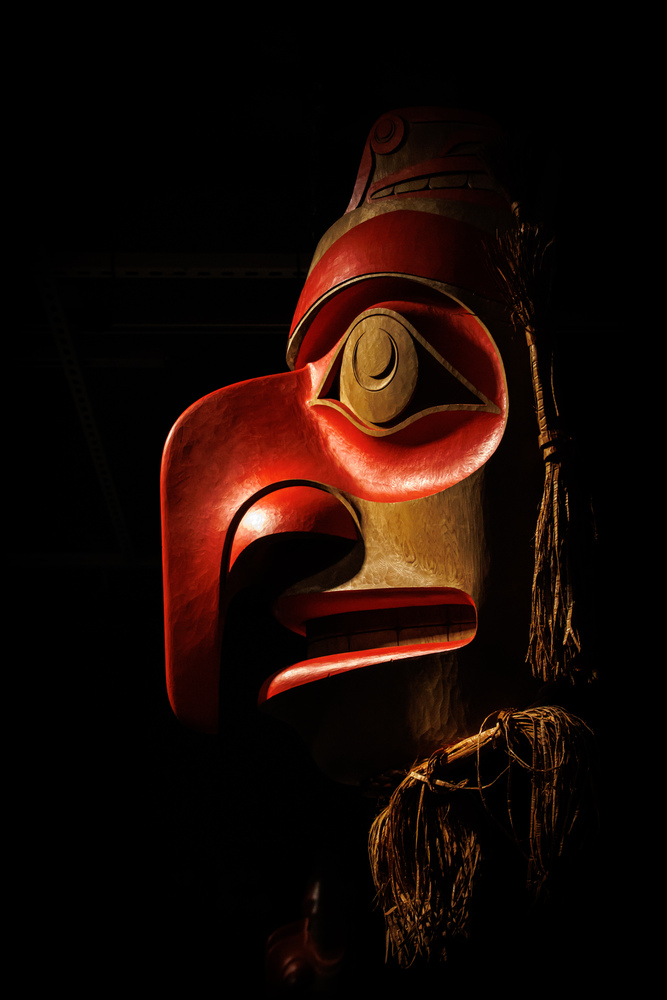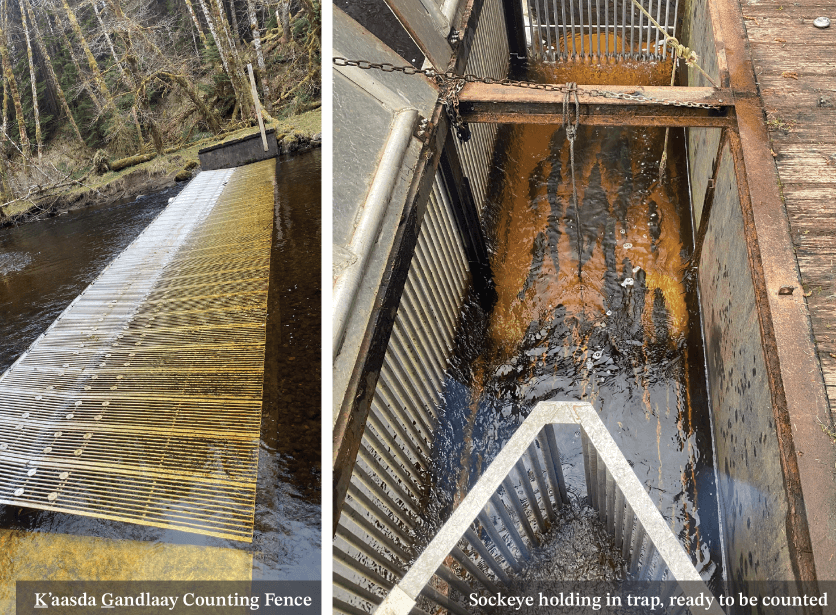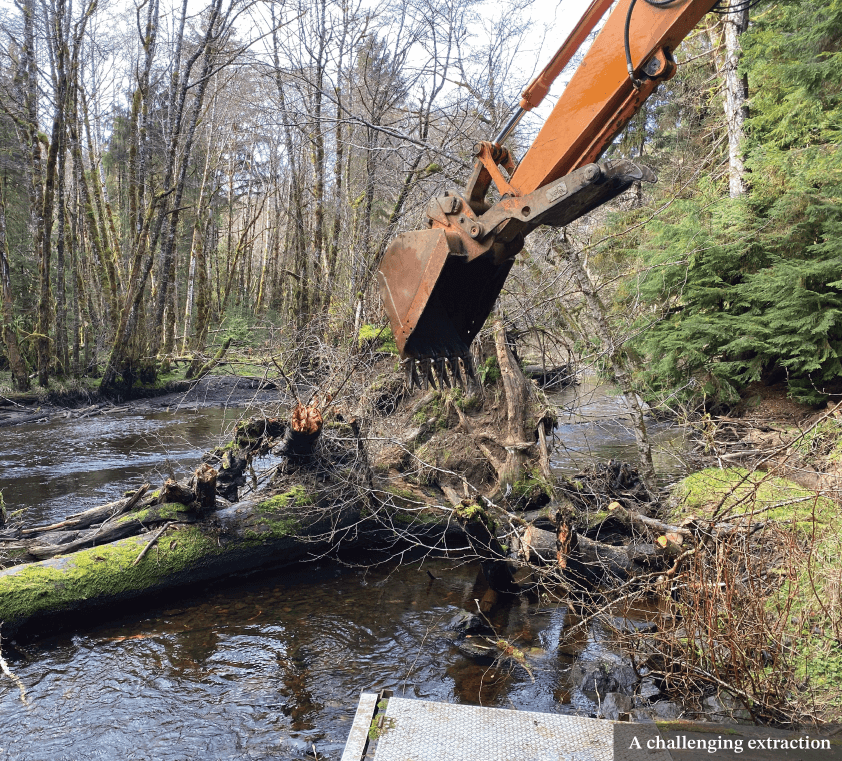| Salmon Stewardship - K’aasda Gandlaay Copper Creek |
 |
| Written by “Jaahljuu” Graham Richard |
| 29 May 2023 |
|
The air vibrates with the voices of the many rills and creeks running down forested hills through glacial till and into K’aasda Siiwaay Skidegate Lake. Running rains and melted snows rest in a large, dark lake at the centre of a calm valley, before they gently curve, bobble, and bend eastwards down K’aasda Gandlaay Copper Creek to a rich, protected estuary. The dark, beautiful river fills surrounding shores with its many pops, whisps, and expressive, song-like voices, reminding of the language this landscape inspired. For thousands of years K’aasda Gandlaay has been a perfect home to salmonids. These include Taaxid Copper River Sockeye, Ts’iit’an Pink, Táay.yii Coho, and Taatl’ad Steelhead and Dolly Varden. The river’s wealth provides in abundance, and generations of busy Haida people filled surrounding lands with homes and worksites. This history of at least 14,500 years of occupation generated riverbanks full of middens and fire cracked rock. Today the river system’s banks form one continuous archaeological site. Over the years K’aasda Gandlaay rises and falls with the seasons, eroding its banks. Recent intensive logging at upland sites has stripped surrounding hillsides, likely exaggerating seasonal flooding. As they wear away, the riverbanks release many objects Kuuniisii Haida ancestors left behind. In the winter of 2020 Haida archaeological teams from Saahlinda Naay Haida Gwaii Museum walked the river to map out old weirs and recover tools and lithic flakes and cores.
Erosional forces aren’t limited to small, precious objects. As flooding undercuts banks, it occasionally washes entire trees off their roots. The winter flooding was powerful enough to move a roughly 8000-pound tree and rootball one kilometre down river. Similarly, four or five years ago a large kayd Sitka spruce tree fell into the current, jamming into the river’s southern bank and effectively spanning the river. There the log collected more and more drifting debris. 40-metres downstream was the K’aasda Gandlaay Counting Fence. The aluminium weir sits just above high tide in the important fishing area. Taaxid arrive in the estuary as early as late winter and usually wait until about mid- to late-May to run upstream. Haida Fisheries Technicians use the fence to count taaxid and determine “escapement”; the amount of salmon that make it upstream. Haida only start to harvest once 10,000 taaxid have passed the counting site. These “spawners” will guarantee that K’aasda Gandlaay will continue to support a healthy taaxid population. This practice has guaranteed that salmon return from year to year, even as over 100 years of industrial overfishing have led many other fish populations to collapse. Haida stewardship reflects the longterm management policies of id Kuuniisii our Ancestors, who cared for Haida Gwaii through ‘WaahlGahl Potlatch. This international legal system bound northeastern Pacific coastal societies together with the natural and supernatural worlds, empowering humans to flourish sustainably for thousands years. In modern times, Haida Fisheries and the Copper Bay Fishing Committee have used the fence and the principles of Kil Yahda Haida law to steward a sustainable Food, Social, and Ceremonial (FSC) fishery since the early 1980s. The K’aasda Gandlaay Counting Fence’s design includes hooks that can lock panels in place while taaxid travel up-stream. Generally these panels merely direct salmon into a counting area as they travel upstream to spawn. However, the winter of 2021/2022 brought one of the weir’s biggest catches ever as large storms flooded the river and dislodged the log jam. It drifted right onto the weir’s cedar sill, where it stuck firmly on the hooks. With such an enormous obstruction covering the sill, Haida Fisheries Technicians wouldn’t be able to count fish and properly steward the taaxid population. In response, an old team of organisations came together to tackle the problem including people from Xaayda GwaayGalang Gan ga Kaaxaajuus Council of the Haida Nation; the Province of BC; and Fisheries and Oceans Canada’s Community Economic Development Program (CEDP). The project is one of several examples in Haida Gwaii of how CEDP seeks to work directly with communities to boost salmon stocks that have steadily declined in population through the decades.
To remove the jammed tree and fully restore the fence to working condition a large excavator was brought to the site. In a river like K’aasda Gandlaay, a large volume of water pushes powerfully against large objects like the fallen kayd. This can create serious hazards should river currents move heavy logs. That’s why the team hired a professional faller to carefully navigate the dangerous situation. Additionally the team chose safe removal methods. Rather than try to pull the log up-river where it would get caught up in thick forest, or push it down-river where it might further damage the fence and its counting station, the team decided to lift it up with the excavator and into a large rock truck. The faller descended the bank and, working with great care in the river’s current, cut the log up into smaller sections. He then choked the pieces up with cable and the excavator lifted them into the waiting rock truck. The kayd was so large that it took several trips to a spoil pit to complete the job. The project at K’aasda Gandlaay is just one of many CEDP funded projects that CHN undertake throughout Haida Gwaii each year. Their work ties into a millenia-old legacy of Haida fisheries management. Through ‘waahlGahl, Haida interweave themselves with a mesh of management laws rooted in Yahguudang respect and aimed at improving abundance over hundreds of generations. Working with CEDP, coastal potlatch people have undertaken all manner of stewardship projects including hatcheries management; habitat conservation and restoration; bio-reconnaissance; water quality monitoring; surveys; mapping; education; and much more. This supports continued Haida management at K’aasda Gandlaay and upholds an ongoing legacy of Yahguudang and intergenerational planning.
Main photo: Jiila Kuns Greatest Mountain the greatest of all Creek Women, who own and beckon the fish back to their respective rivers each year, is also the ancestress of many Eagle lineages on Haida Gwaii. Artist Robert Davidson, c. 2008. Collection: Haida Heritage Centre Collection. PC John Wilson, courtesy Haida Gwaii Museum.
By “Jaahljuu” Graham Richard | Photos courtesy Haida Fisheries |












